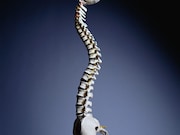Nonoperative tx advised if patient satisfied with spine-related health; surgery may improve outcomes
FRIDAY, Feb. 22, 2019 (HealthDay News) — In as-treated analyses, surgery is superior to nonoperative care at two years among patients with adult symptomatic lumbar scoliosis, according to a study published in the Feb. 20 issue of The Journal of Bone & Joint Surgery.
Michael P. Kelly, M.D., from the Washington University School of Medicine in St. Louis, and colleagues examined the effects of operative and nonoperative treatment and the benefits of these treatments for patients with adult symptomatic lumbar scoliosis. Patients were enrolled in concurrent randomized or observational cohorts: 63 patients in the randomized cohort (30 in the operative and 33 in the nonoperative group) and 223 in the observational cohort (112 and 111 in the operative and nonoperative groups, respectively).
The researchers observed no difference in outcomes at two years of follow-up in an intention-to-treat analysis of the randomized cohort. In the randomized cohort, nonadherence was high. In the as-treated analysis, operative treatment correlated with greater improvement in the Scoliosis Research Society (SRS)-22 subscore and the Oswestry Disability Index (ODI) at the two-year follow-up (adjusted mean difference, 0.7 and −16, respectively). In the observational cohort, surgery was superior to nonoperative care at two years after treatment in terms of the SRS-22 subscore and ODI outcomes.
“If a patient starts with nonoperative treatment and is subsequently dissatisfied or spine health deteriorates with time, surgery may then be considered with an expectation of benefit from surgery,” the authors write.
Several authors disclosed financial ties to the medical device and health care industries.
Copyright © 2019 HealthDay. All rights reserved.








